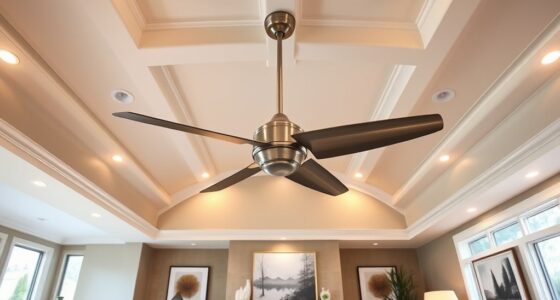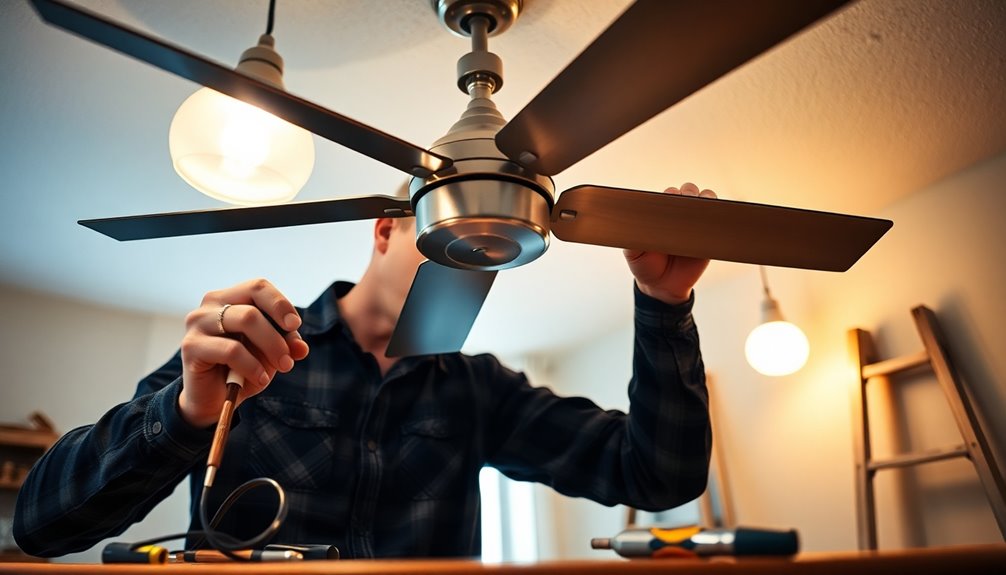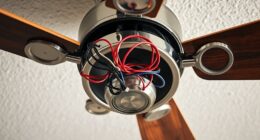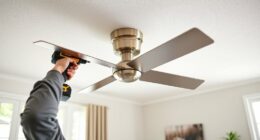In winter, you want your ceiling fan to rotate clockwise at a low speed. This direction helps create an updraft, circulating warm air and distributing heat evenly throughout the room. It prevents cold spots and enhances your heating system's efficiency. Running the fan like this can even save you up to 15% on your heating bills. To change the direction, locate the reversing switch at the fan's base and verify it's off first. By making this simple adjustment, you're setting yourself up for a cozier winter. There's more you can do to maximize comfort and savings as the seasons change.
Key Takeaways
- In winter, ceiling fans should rotate clockwise to create an updraft and redistribute warm air.
- Running the fan at a low speed prevents uncomfortable drafts while enhancing heating efficiency.
- This clockwise direction helps maintain even room temperatures and reduces cold spots.
- Make seasonal adjustments with Daylight Savings Time as a reminder for optimal performance.
- Always check the fan's reversing switch or remote control to ensure proper rotation direction.
Importance of Ceiling Fan Direction
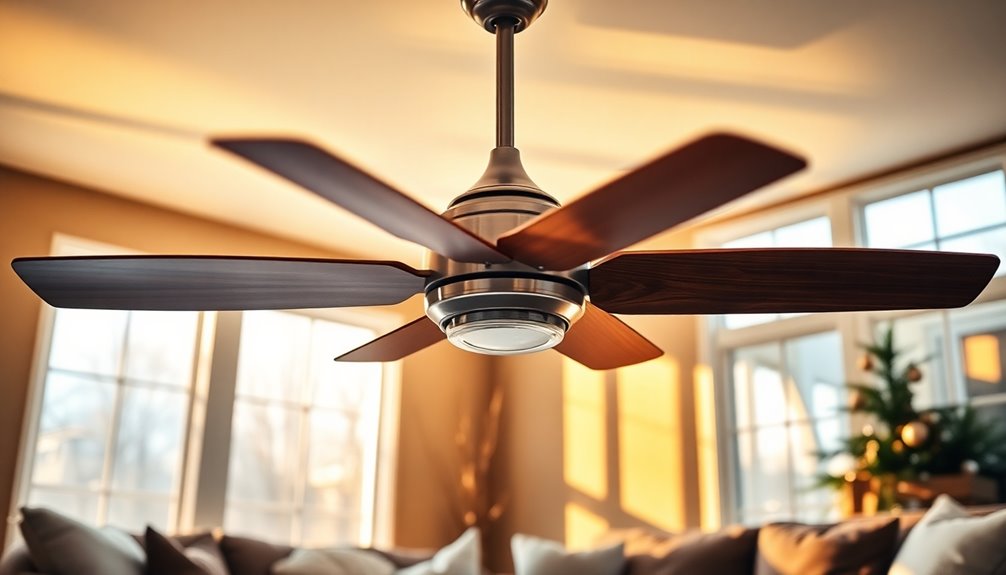
Understanding the importance of ceiling fan direction is essential, especially in winter. Setting your ceiling fan to rotate clockwise creates an updraft, pulling cold air up and pushing warm air down toward the floor. This simple adjustment greatly enhances your comfort by ensuring even heat distribution throughout the room and preventing those pesky cold spots.
When you run your fan at a low speed in this direction, you'll enjoy a cozy atmosphere without the uncomfortable drafts that can disrupt your warmth.
Additionally, modifying your ceiling fan direction can lead to energy savings of up to 10%. By promoting better heat distribution, you can lower your thermostat settings, which can help reduce your energy bills.
Most ceiling fans come with a reversing switch, typically located near the motor, making it easy for you to change the direction according to the season.
Embracing the right ceiling fan direction in winter not only elevates your comfort but also contributes to energy efficiency. So, don't overlook this straightforward adjustment; it can make a great difference in how you experience your space during the colder months.
Recommended Direction for Winter

To get the most out of your ceiling fan during winter, set it to rotate clockwise. This ceiling fan direction creates an updraft that pulls cold air up, pushing warm air down toward the floor. By running your ceiling fan at a low speed, you can evenly distribute heat throughout the room without creating uncomfortable drafts.
Switching to clockwise can greatly enhance your home's energy efficiency. In fact, making this adjustment can reduce heating costs by up to 10%. When your ceiling fan spins in this direction, it helps maximize the effectiveness of your heating system, potentially saving you up to 15% on your heating bills.
Finding the switch to change the fan direction is usually easy; it's often located near the fan base.
Don't forget to make this simple adjustment as the seasons change. By ensuring your ceiling fan is set to the correct direction in winter, you're not just staying comfortable—you're also being mindful of your budget.
How to Change Fan Direction
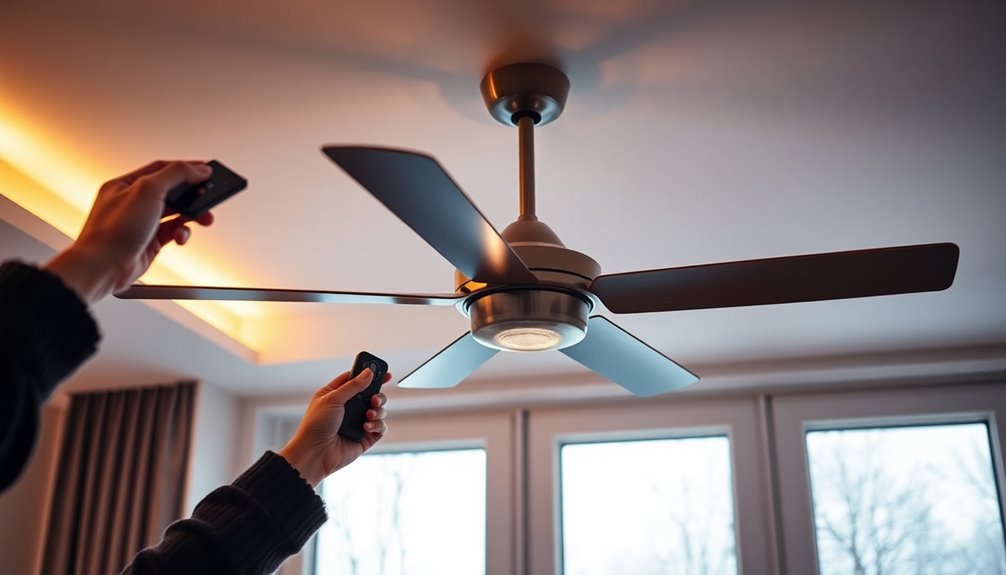
Changing your ceiling fan direction is simple, whether you're using a manual pull chain or smart technology.
For manual fans, just locate the reversing switch and set it to clockwise.
If you've got a smart fan, use the app or voice commands to adjust the direction easily.
Manual Direction Change
When it comes to adjusting your ceiling fan's direction for winter, the process is straightforward and can be done quickly. First, you'll want to turn off the fan and make sure it has completely stopped. This is vital for safety and effectiveness when you change the direction.
Most ceiling fans feature a reversing switch located on the fan body or near the motor, allowing you to toggle between clockwise rotation and counterclockwise rotation.
If you're using a remote-controlled fan, turn it off and press and hold the designated button until the light blinks, indicating the direction has successfully changed.
Once you've made the manual direction change, turn on the fan again and confirm it's now rotating in a clockwise direction. This clockwise rotation is ideal for redistributing warm air during the winter months, helping you maintain a comfortable temperature in your space.
Smart Technology Adjustment
Adjusting the direction of a smart ceiling fan for winter is just as straightforward as with manual models, but it offers added convenience through technology.
Here's how you can easily change the fan's direction:
- Make sure the fan is powered off: This step is essential to avoid any damage or operational issues.
- Access your compatible mobile app: Open the app linked to your smart fan.
- Navigate to fan control settings: Look for the directional adjustment option, usually found in the settings menu.
- Select clockwise rotation: This setting helps with effective heat distribution throughout the room.
If your smart fan includes voice command options, you can simply say, "set fan direction to clockwise," for a hands-free experience.
After making the adjustments, remember to turn the fan back on and confirm direction to verify it operates correctly in the new clockwise setting.
This simple process not only enhances your comfort during winter but also maximizes your heating efficiency.
Timing for Direction Changes

To get the most out of your ceiling fan in winter, timing your direction changes is key.
A great moment to make this switch is during Daylight Savings Time, especially when you fall back in autumn.
This simple adjustment helps you stay warm and can even save you on heating costs.
Optimal Seasonal Timing
An ideal time for changing your ceiling fan's direction is during the Daylight Savings Time adjustments, which makes it easy to remember when to switch things up.
As the seasons change, you want to guarantee your ceiling fan direction is set to maximize comfort and efficiency. For winter, set your fan to rotate clockwise. This will help create an updraft, redistributing warm air from the ceiling downwards.
To optimize your ceiling fan for winter, consider the following steps:
- Change the Ceiling Fan Direction: Switch to clockwise to enhance heat distribution.
- Time Adjustments: Align your changes with Daylight Savings Time for easy recall.
- Energy Savings: Regular adjustments can lead to up to 10% savings on heating costs.
- Seasonal Changes: Make it a habit to check and change your fan direction with each season.
Daylight Savings Adjustments
As you prepare for winter, timing your ceiling fan direction change with Daylight Savings adjustments can simplify the process. The ideal moment to make this switch is during the "fall back" changeover in the fall. By setting your ceiling fan to rotate clockwise, you create an updraft that helps distribute warm air throughout your space. This small adjustment can greatly enhance your heating efficiency, potentially reducing heating costs by up to 10%.
Here's a quick reference table to help you remember:
| Action | Timing |
|---|---|
| Change Direction | Daylight Savings Time (Fall Back) |
| Set Fan Direction | Clockwise |
| Speed for Winter Use | Low Speed |
Always verify that the fan is completely off before making adjustments for safety and proper functionality. By following these guidelines, you'll enjoy a cozy winter with consistent warmth, all while keeping your energy bills in check. So, when Daylight Savings Time rolls around, remember to adjust your ceiling fan direction for maximum comfort and efficiency!
Benefits of Using Fans in Winter

Using a ceiling fan in winter can make a considerable difference in your home's comfort and energy efficiency. By setting your ceiling fan direction to clockwise and running it at a low speed, you can create a gentle updraft that redistributes warm air.
This simple adjustment helps maintain a consistent temperature throughout your space, enhancing your comfort during the winter months.
Here are some key benefits of using ceiling fans in winter:
- Reduced Heating Costs: By using a ceiling fan, you can lower your thermostat settings and reduce heating costs by up to 15%. This can be particularly effective when combined with energy-efficient heat pumps, which are designed to maximize heating efficiency. Additionally, utilizing a ceiling fan can support energy conservation efforts by reducing the overall demand on heating systems.
- Energy Savings: Ceiling fans consume considerably less electricity—around 50 watts—compared to traditional heating systems that can use thousands of watts.
- Improved Air Circulation: Ceiling fans effectively circulate warm air, preventing cold spots and ensuring a more pleasant indoor environment.
- Enhanced Comfort: Regular use of ceiling fans combats the stagnation of warm air, leading to a more comfortable living space throughout the colder months. Additionally, utilizing ceiling fans aligns with energy-efficient technology to maximize heating efficiency.
Embrace the benefits of ceiling fans to enjoy a cozy, energy-efficient winter!
Ceiling Fan Speed Considerations
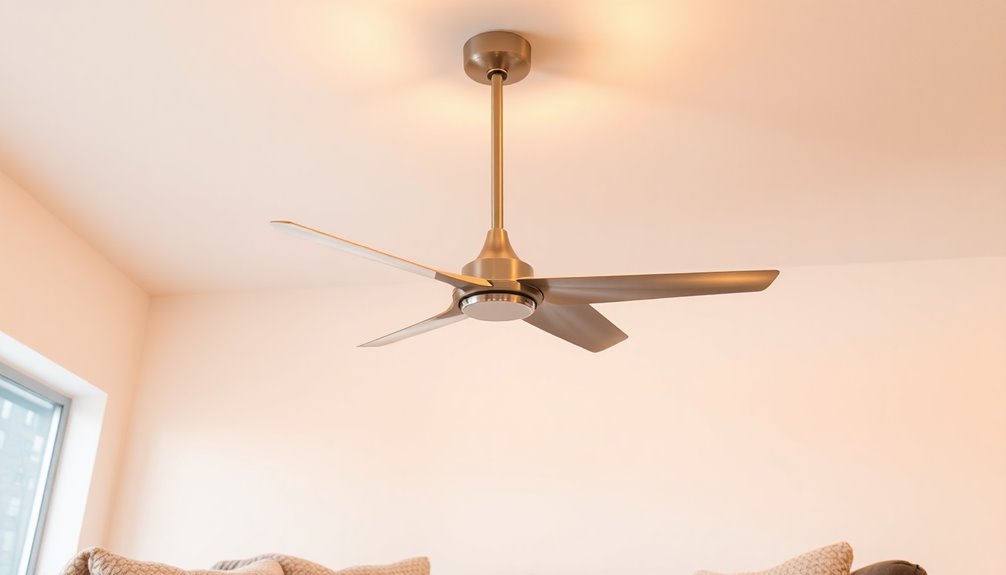
To maximize the benefits of your ceiling fan during winter, adjusting its speed is essential. Set your fan to run at low speed in a clockwise direction. This configuration creates a gentle updraft that helps redistribute warm air without creating uncomfortable drafts.
When you operate the fan at low speed, it pushes the warm air, which naturally rises, back down towards the floor, guaranteeing a more even temperature throughout the room.
By maintaining this low-speed clockwise rotation, you can enhance heat distribution and minimize cold spots, making your space feel cozier. Plus, this simple adjustment can lead to significant energy savings—up to 15% on heating bills. You'll find you can lower your thermostat settings while still enjoying warmth.
It's vital to check the fan's rotation and speed settings visually. Low speeds allow for easy observation of the clockwise movement necessary for effective heat distribution. Additionally, using a ceiling fan in winter can contribute to energy-efficient models, further reducing your heating costs.
Energy Efficiency and Savings
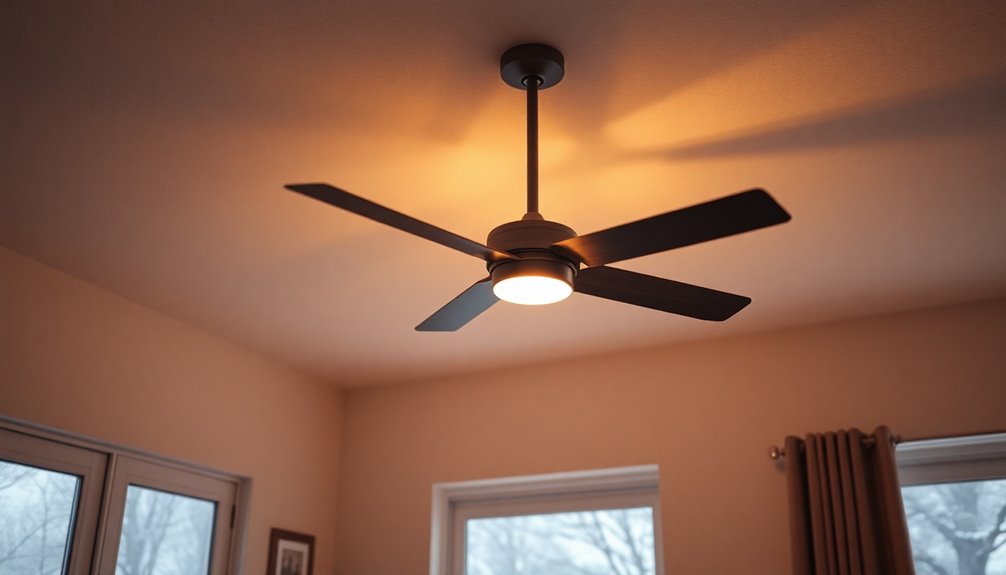
Ceiling fans can be a game-changer for energy efficiency and savings during winter months. By adjusting your ceiling fan direction to clockwise, you can effectively redistribute warmer air that rises to the ceiling, helping to reduce heating costs.
This simple adjustment can lead to significant energy savings and a more comfortable living space. Here are four key benefits:
- Lower Heating Costs: Running your fan in the right direction can decrease heating costs by up to 15%.
- Consistent Room Temperature: A properly adjusted fan helps maintain a steady temperature, allowing you to lower your thermostat settings. Additionally, using energy-efficient systems can further enhance your home's heating performance.
- Energy Savings: You might achieve energy savings of about 10% by preventing heat loss and relying less on heating systems.
- Increased Efficiency: Energy Star-certified ceiling fans can enhance heating efficiency further, potentially reducing energy bills by an additional 8%. Additionally, seasonal promotions on energy-efficient products can help maximize your savings even further.
Common Misconceptions About Fan Use
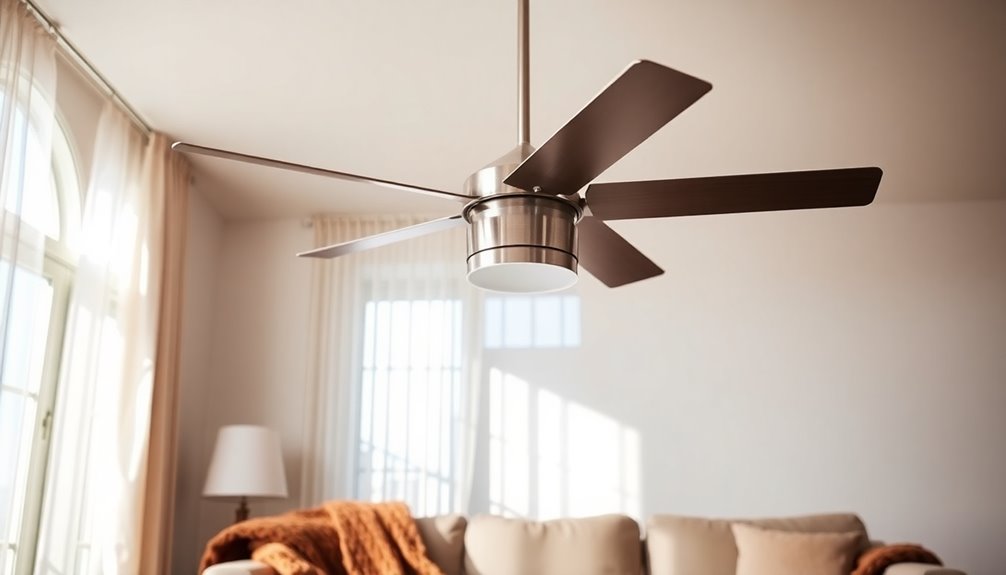
Many homeowners mistakenly think ceiling fans are solely for cooling, overlooking their essential role in winter heating. One common misconception is that ceiling fan direction doesn't impact energy costs. In reality, running your fan clockwise during winter can help reduce heating expenses by up to 10%.
Another myth is that you shouldn't adjust your fan seasonally. However, switching the ceiling fan direction to clockwise can enhance comfort and efficiency.
Some people worry that using fans in winter creates uncomfortable drafts, but when you run them at low speed in the clockwise direction, you'll promote even heat distribution without the chill.
It's also important to note that not all fans are the same. Ceiling fans with reversible motors offer the convenient reverse option, allowing you to easily switch directions for year-round use. Additionally, maintaining a clear area around your fan ensures optimal ventilation and safety while it operates.
Frequently Asked Questions
Do Ceiling Fans Really Help in Winter?
Yes, ceiling fans can really help in winter!
When you run them at a low speed in the right direction, they create a gentle updraft that pushes warm air down into your living space. This circulation prevents cold spots and keeps your home cozy.
Plus, by helping distribute heat more evenly, you might save on heating costs. Just flip the switch on your fan, and you'll instantly feel the difference!
What Way Should a Fan Spin to Cool Down a Room?
To cool down a room, you should set your ceiling fan to spin counterclockwise. This direction creates a cooling downdraft, enhancing the wind chill effect and making the space feel up to 4 degrees cooler.
By operating the fan at high speed, you can also reduce your energy costs by up to 30% during summer.
Just verify the blades have a minimum angle of 12 degrees for ideal airflow without disturbances.
Why Reverse a Ceiling Fan in Winter?
Reversing a ceiling fan in winter helps you save energy, maintain comfort, and eliminate cold spots.
By changing the direction, you create an updraft that pushes warm air down and circulates it evenly throughout the room.
You'll notice a more consistent temperature, which can lead to lower heating bills.
Plus, running the fan on low prevents drafts, enhancing your cozy environment without the chill.
It's a simple adjustment that makes a significant difference!
How to Tell Fan Direction?
To tell the fan direction, stand directly beneath it and observe the blade rotation.
If you feel a gentle breeze, it's likely spinning counterclockwise, indicating it's in cooling mode.
For a clearer view, use the low-speed setting, which allows you to notice the direction without strong air movement.
If you need to adjust it, find the reversing switch on the motor housing or check the app for smart fans to change the direction easily.
Conclusion
In winter, running your ceiling fan clockwise can make a big difference in comfort and energy savings. It pushes warm air down, helping you feel cozier without cranking up the heat. Did you know that using ceiling fans strategically can save you up to 15% on your heating costs? That's money back in your pocket while keeping your home warm. So, don't underestimate the power of a simple fan—make the switch this winter and enjoy the benefits!




